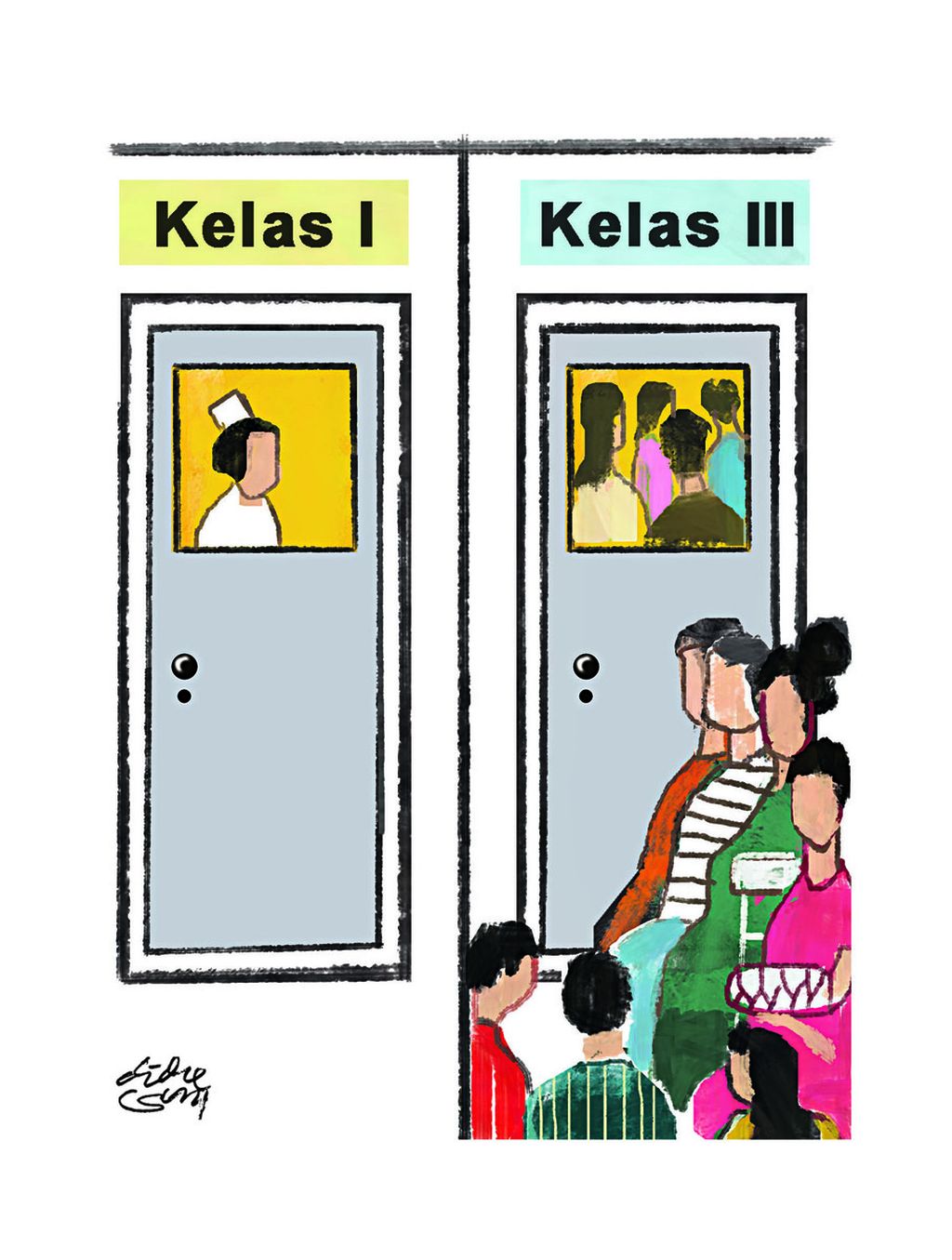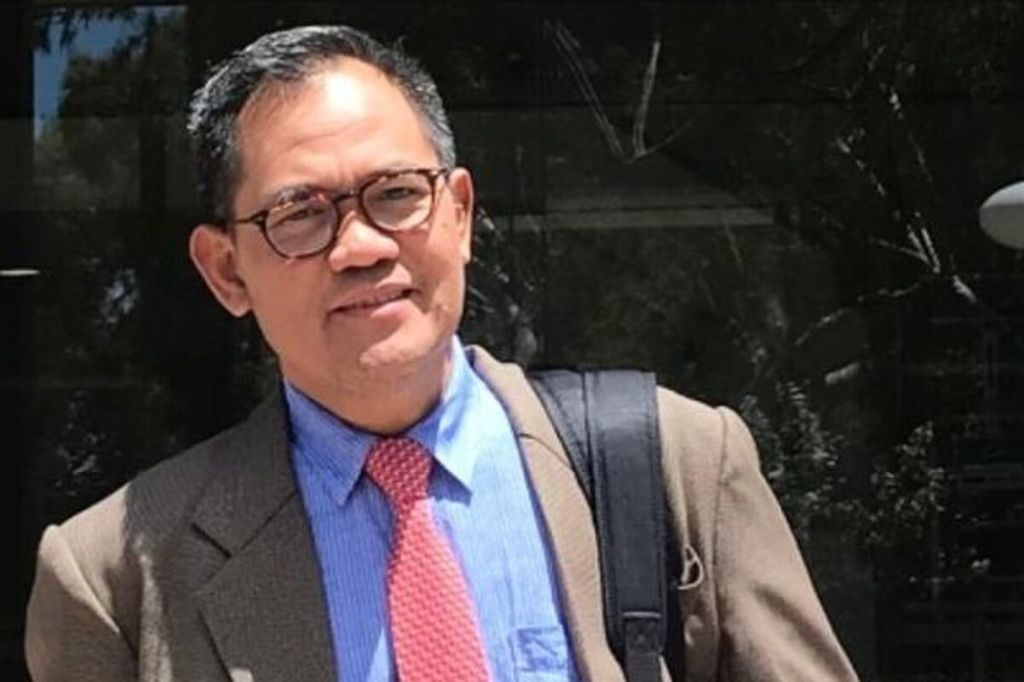Joint Healthcare Provision to Patch Up BPJS Shortfall
The government must rearrange its regulations properly with an aim of preventing the tendency of insurance companies to implement adverse selection.

Some time ago, Health Minister Budi Gunadi Sadikin raised the idea of a special health insurance package for the wealthy provided by the Healthcare and Social Security Agency (BPJS Kesehatan). The idea duly drew pros and cons.
The suggested special BPJS health insurance for the wealthy is a package that, as expected, involves private insurers providing joint medical coverage. Kompas has published at least four opinion articles responding to the Health Minister's idea, which he put forward during a work meeting with the House of Representatives (DPR) at the end of 2022.
The first to respond was Joko Mulyanto, an academic at the medical school of Jendral Soedirman University (Unsoed), with his article “Jaminan Kesehatan bagi Orang Kaya” (Health insurance for rich people) published on 10 Dec. 2022. He was followed by Laksono Trisnantoro, a special staffer to the health minister. In his article titled “Menangani Masyarakat Mampu di JKN” (Dealing with financially abled people at JKN) published on 15 Dec. 2022, he clarified the basis of the health minister's concern.
Then came Ahmad Fuady from the University of Indonesia (UI) medical school, who voiced his skepticism over the issue in “Jaminan Kesehatan Nasional: Proteksi untuk Siapa? (National Health Insurance: Protection for whom?), published on 2 Jan. And finally, BPJS managing director Ali Ghufron Mukti, a former deputy health minister, presented his opinion in “BPJS, Siapa Paling Diuntungkan?” (BPJS, who benefits the most?), published on 27 Feb.
Also read:
> BPJS: Who Benefits the Most?
> Health Insurance for Rich People
They were enlightening discussions featuring competent experts with supporting data and arguments, so they provided relatively complete understanding about the BPJS’s problems. These discussions provided initial policymaking resources to improve the BPJS so it can provide more equitable and fair facilities.
Fuady explains why inequitable healthcare access continues to persist. Citing Sambodo (2021), he says that public spending on health care is still dominated by healthier economic brackets, partly due to the uneven distribution of healthcare facilities. Two-thirds of the total 61 high-quality hospitals (formerly called Class A) are on Java Island, of which 16 are in Jakarta.
The ENHANCE study (2022) also shows that people in the economically weak segment do not have many options for accessing health care, leaving them with healthcare services that have limited facilities and are low quality. BPJS use has so far dominated by more affluent people, while those in the middle to low economic brackets are reluctant to take advantage of the facility.
Even though healthcare services are available for free, National Health Insurance (JKN) participants still have to pay non-healthcare costs, such as transportation, accommodation, and even potential deprivation of daily incomes. With high nonmedical costs due to limited facilities and the distant location of healthcare centers, some cannot afford health services or must think twice before deciding to use health services. This is not the case for more financially abled people.
These discussions provided initial policymaking resources to improve the BPJS so it can provide more equitable and fair facilities.
On the other hand, it appears that only 48 percent of the approximately 30 million participants of the nonwage worker (PBPU) scheme paid JKN premiums in 2021. The BPJS contributions from this group accounted for only 8 percent, compared to the 34 percent in contributions from government assistance beneficiaries (PBI). Fuady's explanation is quite intriguing. It turns out that access to and use of healthcare services still has a wide gap.
He put forward the idea of "risk adjustment" to improve the JKN scheme. It aims to rectify the rates for premiums, of which he says categorizing into classes 1, 2 and 3 is not appropriate.
The idea is to impose progressive premiums. For example, a participant obligated to pay a monthly premium of Rp 150,000 and entitled to basic health services may have their premium augmented if they want a number of benefits above their rate. For example, a participant who is diagnosed with kidney failure in the second year of their membership and needs to access dialysis services every two weeks will have their premium adjusted, to Rp 400,000.

incorporated insurance
Apart from risk adjustment, Fuady raised a bold suggestion to allow another BPJS-like health insurance provider to operate and abolish BPJS Kesehatan’s monopoly. The presence of a competitor was expected to help ensure service quality.
The idea is attractive for discussing, but seems difficult to realize. Instead of raising a competitor, it will be more realistic to design collaboration between BPJS and a private insurer. Let’s call it an incorporated insurance program.
Combining the health coverage provided by the BPJS and a private insurer is actually not a new idea. Stipulated in Presidential Regulation No. 111/2011, Article 28, this possibility has been planned for since 2013. Unfortunately, as it is still undergoing many revisions, the plan has yet to be realized until this day. A program that combines health benefits is called coordination of benefits (CoB), which incorporates the benefits provided by BPJS Kesehatan and a private insurer. It is intended to complement BPJS Kesehatan facilities, because the private insurer is unable to provide comprehensive health services.
A CoB program can bring additional benefits, compared to being registered with only either of the two providers. Among these is that a participant can upgrade their hospital room from class 1 to VIP at no extra cost. In addition, several types of hospital treatment that are not fully covered by the BPJS become accessible, with the cost shortfall to be borne by the private insurer as a co-provider. This way, the services the participants are entitled to can be delivered right away without administrative barriers, because there is no need to assess how much of the costs are to be borne by BPJS Kesehatan. Patients can receive immediate treatment. If it turns out that the cost exceeds the BPJS-administered limit, the shortfall is borne directly by the co-provider.
Preventing ‘risk selection’
Private insurance companies have been criticized for being too selective – many people even consider them to be discriminatory – in screening prospective subscribers. An elderly person known to have acute illness is unlikely to be accepted. Suppose that they are accepted, the premium they pay would be very high. Actually, this is reasonable because private insurance companies operate under the profit-oriented business model.
An aging participant with a medical history of various acute illnesses would be seen as a “loss center”, not a “profit center” that would potentially erode the insurance company's coffers. On the other hand, young or teenaged participants who are healthy with no history of serious illness, let alone athletes, are profit centers that promise to be “gold mines” for insurance companies. Such subscriber profiles are what private insurance companies are surely targeting.
It is not that there has been no effort to deal with this situation. In the United States, the Affordable Care Act (ACA) has been in place since 2014, which states that insurance companies can no longer withhold coverage liability or charge higher premiums to clients based on their medical records, such as diabetes mellitus, chronic kidney disease, and lupus. This regulation aims to make it easier for insurance subscribers to get coverage, including those previously known to have had certain diseases.
Also read:
> Ensuring Healthcare Services
The ACA can indeed be a threat to insurance companies. If it is not accompanied by strict and prudent regulations, this provision has the potential to destabilize the private health insurance industry. So, private insurance companies must be smart in formulating the packages they offer that provides coverage for subscribers with a history of acute illness while ensuring that consumers gain valuable benefits from the premiums they pay.
How to determine the premium rate for new subscribers who have a history of various illnesses? One way is to implement three provisions to improve the health insurance system, which are risk adjustment, reinsurance, and risk corridor. This aims to encourage healthy competition among insurance companies based on quality and value, and to encourage stability in the insurance sector, especially at the early stage when the improvement measures are launched.
How to determine the premium rate for new subscribers who have a history of various illnesses?
In this context, the "risk adjustment" option, as alluded to by Fuady, is interesting because it applies the principle of proportionality for clients, with respective conditions and risks. For example, clinical practices treat patients that have been assessed for risk differently from others with different health conditions. The data shows that people with diabetes who also have heart disease have a shorter life expectancy than people with diabetes who do not have heart disease.
A 60-year-old person with diabetes has a reduced life expectancy of around 6 years. If they also have heart disease, their life expectancy is reduced by 12 years. This creates consequences for treatment, such as adopting a healthy lifestyle, medical care and proper drug consumption, and may require a heart ring/stent placement. These consequences are then taken into consideration by private insurance companies when assessing potential subscribers.

Efficiency plans
What is called "risk adjustment" is an effort to mitigate the possible risk from an applicant's uncertain health status. This makes insurance companies cautious in offering their products.
Mitigation efforts are becoming more urgent, given the rule that insurance companies may no longer refuse coverage or charge higher premiums based on a patient's medical history. To prevent potential losses due to the high number of new applicants with acute diseases, insurance companies will carry out adverse selection and risk selection.
Adverse selection prompts a high average premium, which may in turn disrupt the insurance sector and put the government in a difficult situation in managing the healthcare system. Uncertainty about an applicant's health also makes insurance companies cautious about offering their products. As a result, the premium rate becomes too conservative.
Therefore, the government must rearrange its regulations properly with an aim of preventing the tendency of insurance companies to implement adverse selection. The government must prevent people from having to wait until they are sick before taking out insurance. The concrete actions are to limit insurance applicants during an “open period”, and instead encourage registration at a specially designated time. Do not open registration in the “open period”. Encourage people to have liability insurance, even to pay fines if necessary.
Another selection method is "risk selection". This method is applied when insurance companies seek to avoid people who are at high risk of or in poor health for whom medical services will be expensive. Insurance companies will try to capitalize on regulatory loopholes to avoid such a risk.
Also read:
> Reforming the Health Architecture
In principle, the "risk adjustment" program, along with reinsurance and risk corridor, is intended to protect against the negative effects of the "adverse selection" and "risk selection" methods. It also works to stabilize premiums. The risk adjustment program is carried out to strengthen the market, whose enforced rules prohibit risk selection by insurance companies. The idea is that the premiums for low-risk subscribers will subsidize high-risk subscribers.
This makes insurers competitive in terms of the value and efficiency of their insurance plans, rather than simply striving to lure young and healthy applicants. In this case, the government needs to regulate a risk corridor, criteria for levies and payments, funding sources, and program duration. Thus, the incorporated insurance program will be in line with the Health Minister's statement regarding the need for private insurance to support health services’ financing needs that so far have not been fully met by BPJS Kesehatan.
The latest development is that several hospitals have begun to design executive polyclinics. While patients continue to use the BPJS facility, the hospital requires an additional fee of a maximum Rp 400,000. This extra fee is called Additional Health Insurance (AKT). Several other hospitals are in the process of applying for a license to open an executive polyclinic. It means that healthcare providers have begun to respond to the Health Minister’s appeal, and this will hopefully further encourage improvements in the BPJS.

Djoko Santoso
Djoko Santoso, Professor of medicine at Airlangga University; head of health at the East Java chapter of the Indonesian Ulema Council (MUI)
This article was translated by Musthofid.